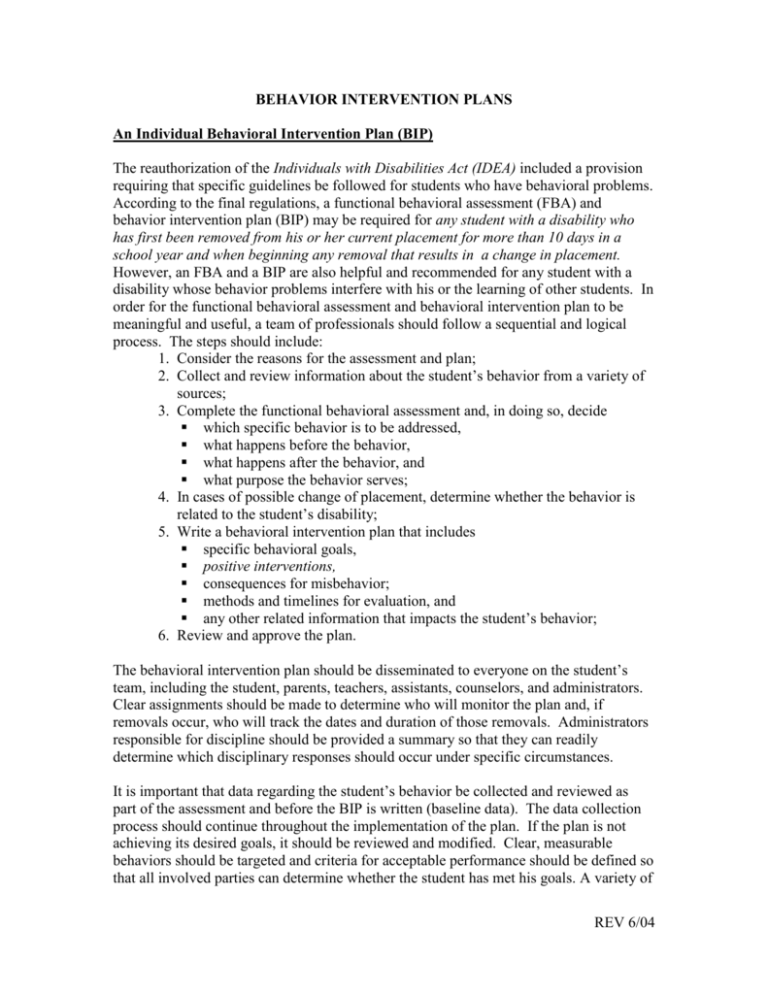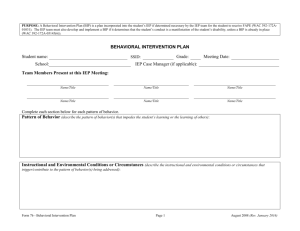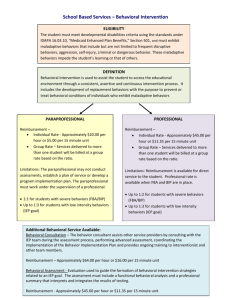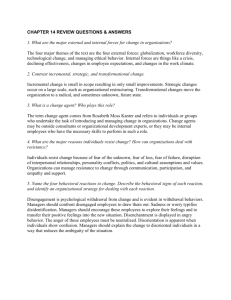BEHAVIOR INTERVENTION PLANS
advertisement

BEHAVIOR INTERVENTION PLANS An Individual Behavioral Intervention Plan (BIP) The reauthorization of the Individuals with Disabilities Act (IDEA) included a provision requiring that specific guidelines be followed for students who have behavioral problems. According to the final regulations, a functional behavioral assessment (FBA) and behavior intervention plan (BIP) may be required for any student with a disability who has first been removed from his or her current placement for more than 10 days in a school year and when beginning any removal that results in a change in placement. However, an FBA and a BIP are also helpful and recommended for any student with a disability whose behavior problems interfere with his or the learning of other students. In order for the functional behavioral assessment and behavioral intervention plan to be meaningful and useful, a team of professionals should follow a sequential and logical process. The steps should include: 1. Consider the reasons for the assessment and plan; 2. Collect and review information about the student’s behavior from a variety of sources; 3. Complete the functional behavioral assessment and, in doing so, decide which specific behavior is to be addressed, what happens before the behavior, what happens after the behavior, and what purpose the behavior serves; 4. In cases of possible change of placement, determine whether the behavior is related to the student’s disability; 5. Write a behavioral intervention plan that includes specific behavioral goals, positive interventions, consequences for misbehavior; methods and timelines for evaluation, and any other related information that impacts the student’s behavior; 6. Review and approve the plan. The behavioral intervention plan should be disseminated to everyone on the student’s team, including the student, parents, teachers, assistants, counselors, and administrators. Clear assignments should be made to determine who will monitor the plan and, if removals occur, who will track the dates and duration of those removals. Administrators responsible for discipline should be provided a summary so that they can readily determine which disciplinary responses should occur under specific circumstances. It is important that data regarding the student’s behavior be collected and reviewed as part of the assessment and before the BIP is written (baseline data). The data collection process should continue throughout the implementation of the plan. If the plan is not achieving its desired goals, it should be reviewed and modified. Clear, measurable behaviors should be targeted and criteria for acceptable performance should be defined so that all involved parties can determine whether the student has met his goals. A variety of REV 6/04 interventions, unique to the individual student, should be implemented. The regulations are very clear that positive interventions must be included in the BIP. Observation Checklist for Component 6: Behavioral Intervention Plan (BIP) and FBA Indicator Components of a Functional Behavioral Assessment and Behavioral Intervention Plan: Notes/Comments o Clear Description of the Behavior(s) Targeted for Intervention *Observable, measurable behaviors o Summary of Related Information Gathered from a Variety of Sources *Formal and informal assessment data *Interviews with teachers and parents *Discipline and attendance data o A Thorough Assessment of the Behavior(s) *What happens before, what happens after, and a hypothesis of the function of the behavior o In Cases of Placement Change, a Manifestation Determination *Consideration of whether the serious behaviors leading to the placement change are related to the disability o A Well Written BIP Including All Components *Specific Goals, Positive Interventions, Designation of Personnel Responsible, Criteria for Success, and Methods and Schedules for Evaluation REV 6/04 Functional Behavioral Assessments (FBA) The 1997 reauthorization of the Individuals with Disabilities Education Act mandates that schools conduct a functional behavioral assessment when a student exhibits behavior that disrupts the educational environment interferes with their education or will result in suspension. Five Main Components Component One 1. A clear description of the problem behaviors. 2. Identification of the events, times, and situations that predict when the problem behavior will and will not occur throughout the typical day. 3. Identification of the consequences that maintain the behavior. 4. Development of one or more summary statements or hypothesis that describe specific behaviors, a specific type of situation in which they occur, the possible function that the behavior serves, and the outcomes or reinforcers maintaining them in that situation. 5. Collection of direct observation data that support the summary statements that have been developed. Define the behavior in observable, factual terms: Component Two Component Three Antecedent: Identify the factors that typically precede the behavior. External factors: Internal factors: Time Moods Activity Medical conditions Setting Disabilities People Events Example: John refuses to do his assignments in 3rd period History and 4th period English. EXAMPLE: John refuses to work. When given assignments that require reading he will shove his books to the floor and put his head down. He becomes defensive and uses vulgar language towards the teacher when the teacher attempts to redirect his behavior. Consequences: Identify what typically follows the behavior. Teacher attention Poor attention Verbal Warning/Reprimand Time Out Detention Removal from class ISS Example: When John refuses to complete his assignments and uses vulgar language the teacher fills out a discipline referral form and calls security to escort him to the office for the remainder of the period. REV 6/04 Component Four Example of a Hypothesis/Function Hypothesis (Function): What is the purpose that you think the behavior serves? Escape/avoidance Attention Expression of anger Frustration Vengeance Seeking power/control Intimidation Sensory stimulation Relief of fear or anxiety Acceptance John is a 7th grade student that reads on a 2nd grade level. He avoids assignments in History and English that require extensive reading by engaging in behavior, such as, refusing to work and using foul language, that will result in his removal from the classroom. Component Five The Functional Behavioral Assessment 1. Open student file 2. Select ARD documents 3. Select ARD meeting forms 4. Select ARD Committee Meeting Report 5. Click on page 3 6. Click Special Disciplinary Procedures/ Functional Behavior Assessment Direct observation data examples: Observation forms Discipline referral forms Attendance records Interview forms Behavior graphs/tally sheets Scatter plots Point sheets Behavior logs Steps for Completing the Special Disciplinary Procedures/Functional Behavioral Assessment 1. Complete Student Data 2. Special Education Staff; Name of Special Education teacher completing the FBA 3. Answer the Yes/No Statements This student’s behavior impedes his/her learning or that of others. Special behavior intervention strategies may be necessary to assist this student in addressing problem behaviors. 4. If the answer is Yes to either question, proceed with the FBA. Behaviors reported by Parents, Teachers, and Counselors Component One: Describe the behaviors in observable, factual terms. (Example): The teacher states that on the playground, in the cafeteria, and during transitional periods Casey hits, kicks, and pushes other students. She does this when she is not first in line, when they have an item that she wants, or when they do not comply with her wishes. The students avoid conflict by giving in to her wishes. The parents state that Casey hits, kicks, and pushes her little brother when he has something she wants. She will also hit her parents when she does not get her way. REV 6/04 What Happens Before the Behavior Occurs? Prioritized Targeted Behaviors Component two (Antecedent) Identify the factors that typically precede the behavior. Example: Casey displays the inappropriate behavior during unstructured and transitional times (Antecedent). Select a small number of behaviors to focus on. These behaviors should be the most critical for the student’s success in school. (No more than two or three) Prioritize the student’s behaviors, and then select the most important behavior to consider first. Function of the Targeted Behavior Example: Component four: Hypothesis/Function What is the purpose that you think the behavior serves? All behavior serves a function. It allows us to: get, escape, avoid something or communicate some other message or need. In unstructured time when Casey does not get what she wants (antecedent), such as; being first or obtaining in object, she will hit, push and kick (behavior) others in order to gain control (function). In order to avoid conflict students give in to her wishes (consequence). Behaviors Manifested in the Past Year Consequences/Reinforcers The Related to DIS section is optional. 1. In the first column, check any behaviors that have been manifested in the past year. 2. In the second column, check off any behaviors that an ARD Committee has previously determined to be related to the student’s disability. For each consequence/reinforcer indicate the frequency it was used during the past year and determine how effective it was in altering the student’s behavior. Example of frequency: Weekly Twice a day Monthly 5 times Note: This information will assist in determining the most effective consequences or reinforcers in the development of the behavior intervention plan. REV 6/04 Identify reinforcers or consequences that have not been tried but might be Contingency Plan effective: Reinforcers Consequences Check off options that may be considered in the development of the behavior Special passes Phone call home intervention plan. Contract Office referral Computer time Reduce time for Note: This section does not socialization Constitute the Behavior Reduced monitoring Escort Intervention Plan. time Note: When trying to determine the best Identify any behavior management reinforcer or consequence, use knowledge techniques that the parent has requested not of the student’s preferences and strengths. be used with the student. YES/NO The Behavior Intervention Plan Check yes/no whether or not goals and objectives for increasing positive behaviors and/or negative behaviors have been included in the IEP. Once the Functional Assessment is complete and the ARD committee has a clear understanding of the antecedents and consequences that maintain the function of the behavior, the ARD committee must determine if there is a need for a Behavior Intervention Plan. If the ARD committee determines that there is a need for a Behavior Intervention Plan, proceed to the goals and objectives portion of the IEP. Goals and Objectives Using the information that has been collected and analyzed in the Functional Behavioral Assessment identify specific goals and objectives that directly address the prioritized behaviors on the FBA. Goal Example: The student will demonstrate appropriate physical action towards others. Objective Example: Casey will refrain from hitting, kicking or pushing others. REV 6/04 Mastery Criteria Guidelines for Selecting Strategies Determine what percentage will constitute mastery based on the student’s level of abilities and the level of the behavior. 1. The intervention must align with the function of the behavior. 2. The intervention must include proactive strategies that teach the replacement behavior. Note: Physical aggression should always be 3. The intervention must include a 100%. continuum of positive and negative consequences. Replacement Behaviors When selecting an intervention and choosing a replacement behavior, you must first determine if the inappropriate behavior is the result of a skill deficit or performance deficit. Skill Deficit The student does not perform the desired appropriate behavior because they do not know how to do it. Example: A student may engage in physically violent behavior because they believe violence is necessary to efficiently end a confrontational situation. Intervention: Teach specific problem solving and conflict resolution techniques the student can use in a confrontational situation. Performance Deficit Reinforcers/Consequences The student may have the skills needed to perform the appropriate behavior, but either chooses not to use them or can not perform the behavior for reasons such as anxiety, anger, frustration, or a medical condition. Example: The student makes rude comments in class in order to make peers laugh. Intervention: Teach the student appropriate ways to gain peer attention, then reinforce the appropriate behavior with an extrinsic motivator. General Education: Specify the reinforcers and consequences that will be used in the general education setting. Example: In the mainstream classroom, the general education teacher will: Use verbal praise Utilize the behavior contract chart Complete point sheets Request for assistance as needed REV 6/04 Reinforcers/Consequences Initial Evaluation Criteria Special Education: Identify reinforcers and the continuum of consequences that will be used in the special education setting. Determine how you will evaluate the effectiveness of the Behavior Intervention Plan. Example: Reinforcers Example: Problem behavior Evaluation method Truancy Off Task Fighting Calling out Attendance Point sheet Office referrals Behavior chart Consequences verbal praise earn points trading daily reinforcement tickets store behavior chart not earn points not earn privileges removal office referral call home ISS Conclusion In order to effectively change a student’s behavior, we must develop a Behavior Intervention Plan that incorporates the following: Proactive teaching strategies Replacement behaviors that serve the same function as the inappropriate behavior A continuum of both positive and negative consequences The content of the plan must be based on the information gained through the Functional Behavior Assessment. REV 6/04






